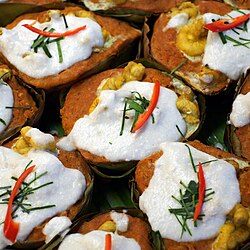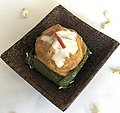food.wikisort.org - Dish
Steamed curry (Khmer: អាម៉ុក, amŏk [ʔaːmok]; Thai: ห่อหมก lit. 'bury wrap',[4] ho mok [hɔ̀ː.mòk], Lao: ຫມົກ, mok [mók]) is a Southeast Asian type of curry steam-cooked in banana leaves.[5] In Laos it is also roasted on embers.[6] The base of the curry is made with a curry paste (Khmer: គ្រឿង, krœăng [krɨəŋ]; Thai: พริกแกง, prik kaeng) with or without the addition of coconut cream or coconut milk and eggs. A wide range of leaves and staple ingredients are also added to the dish, such as:
- fish (Khmer: អាម៉ុកត្រី, amŏk trei [ʔaːmok trəj]; Thai: ห่อหมกปลา, ho mok pla [hɔ̀ː.mòk plāː]; Lao: ຫມົກປາ, mok pa [mók paː]);
- bamboo shoots[7] (Thai: ห่อหมกหน่อไม้, ho mok no mai [hɔ̀ː.mòk nɔ̀ː máːj]; Lao: ຫມົກຫນໍ່ໄມ້, mok nor mai [mók nɔ̄ː mâj] (often with minced meat inside));
- chicken (Khmer: អាម៉ុកសាច់មាន់, amŏk săch moăn [ʔaːmok sac mŏən]; Thai: ห่อหมกไก่, ho mok kai [hɔ̀ː.mòk kàj]);
- snails[8] (Khmer: អាម៉ុកខ្យង, amŏk khyâng [ʔaːmok kʰjɑːŋ]);
- tofu (Khmer: អាម៉ុកតៅហ៊ូ, amŏk tauhu [ʔaːmok tawhuː]; Thai: ห่อหมกเต้าหู้, [hɔ̀ː.mòk tâw.hûː]);;
- algae (Lao: ຫມົກໄຄ, [mók kʰáj] (with Mekong weed)).
 Thai steamed fish curries (ho mok pla) in Chiang Mai, Thailand | |
| Type | Curry |
|---|---|
| Place of origin | Cambodia[1][2][3] or Thailand[4] |
| Region or state | Southeast Asia |
| Associated national cuisine | Cambodian, Lao and Thai |
| Main ingredients | Curry paste, coconut cream/coconut milk, eggs |
| Variations | Fish amok |
According to cultural anthropologist Penny Van Esterik, the Southeast Asian coconut-based curries are the result of Indianization, that in the 15th century after the Fall of Angkor, were introduced in the Ayutthaya Kingdom by Khmer royal cooks and later reintroduced back into Cambodia as the Siamese armies attacked into Cambodia. Nowadays, they are considered characteristic of individual Southeast Asian cuisines.[9]
- Cambodian steamed fish curry (fish amok)
- Laotian steamed fish curry (mok pa)
- Thai steamed seafood curry (ho mok thale) served in a coconut
See also
- Otak-otak, similar fish dumpling, a Nyonya Peranakan cuisine common in Malaysia, Singapore and Indonesia
- Pepes, Indonesian dish cooking method by wrapping in banana leafs
- Botok, similar Indonesian Javanese dish wrapped in banana leaf
References
- Alford, Jeffrey; Duguid, Naomi (2000). Hot Sour Salty Sweet: A Culinary Journey Through Southeast Asia. Workman Publishing Company. p. 180. ISBN 978-1579-6511-4-5.
Steaming fish or chicken with aromatics in banana leaf packets is a technique found from Yunnan to Cambodia. The technique is mawk in modern Thai, Lao, and Khmer, and the word and technique may originally be Khmer.
- "Michelin-starred chef David Thompson explains his growing love for Cambodian cuisine". Aqua Expeditions. June 13, 2019. Retrieved May 26, 2021.
If the description of fish amok sounds like Thai cuisine (arguably the most popular Southeast Asian cuisine in the world), that’s because many elements of today’s Thai cooking was influenced by Khmer cooking techniques and principles perfected over centuries. (...) A dish that exemplifies Khmer influence, is fish amok, a steamed snakehead fish curry that is redolent of lemongrass, galangal and coconut aromas.
- Mouritsen, Ole G.; Styrbæk, Klavs (2021). Octopuses, Squid & Cuttlefish: Seafood for Today and for the Future. Translated by Johansen, Mariela. Springer Publishing. p. 193. ISBN 978-3-030-58026-1.
The Cambodian national dish, amok, variations of which are found as mok in Laos and ho mok in Thailand, is an exceptionally delicious dish, which dates back to the royal Cambodian Angkor-Khmer kitchen.
- Lees, Phil (May 25, 2007). "The Dish: Fish Amok". The Wall Street Journal. Retrieved 7 October 2019.
The origins of fish amok are a source of regional debate. Dishes of this kind aren't unique to Cambodia. Malaysia and Indonesia boast the similar otak otak and Thailand cooks a spicier hor mok but neither nation embraces them with the passion of Cambodia. "Amok" in the Cambodian language, Khmer, only refers to the dish whereas in Thai, "hor mok" translates as "bury wrap," suggesting amok may have come from Cambodia's neighbor.
- Mouritsen, Ole G.; Styrbæk, Klavs (2021). Octopuses, Squid & Cuttlefish: Seafood for Today and for the Future. Translated by Johansen, Mariela. Springer Publishing. p. 254. ISBN 978-3-030-58026-1.
amok - (also mok, ho mok) in southeast Asian cuisine a curry that is steamed in a banana leaf, typically made with fish, galangal, and coconut cream and served with cooked rice.
- Ken Albala, ed. (2011). Food Cultures of the World Encyclopedia. Vol. 3. Greenwood Publishing Group. p. 149. ISBN 978-0-313-37627-6.
- Souvanhphukdee, Andy (July 3, 2019). "Bamboo shoots steamed in Banana leaves (Mok Naw Mai)". Pha Khao Lao. Retrieved May 26, 2021.
- Curry: Fragrant Dishes from India, Thailand, Vietnam and Indonesia. DK. 2006. p. 268. ISBN 978-0-7566-2078-3.
- Van Esterik, Penny (2008). Food Culture of Southeast Asia. Greenwood Press. p. 15. ISBN 978-0-313-34419-0.
Indianization brought the coconut-milk style of Southeast Asian curries to Burma; curries once popular only in the courts are now considered to be characteristic of particular national cuisines. Indianization continued indirectly in the fifteenth century as Khmer cooks brought Indian-style coconut-based curries and boiled red and white sweets, used in Brahmanstyle rites of passage from Angkor Wat to Ayutthaya, and reintroduced them back into Khmer palace kitchens as Siamese armies ravaged parts of Cambodia.
Другой контент может иметь иную лицензию. Перед использованием материалов сайта WikiSort.org внимательно изучите правила лицензирования конкретных элементов наполнения сайта.
WikiSort.org - проект по пересортировке и дополнению контента Википедии


